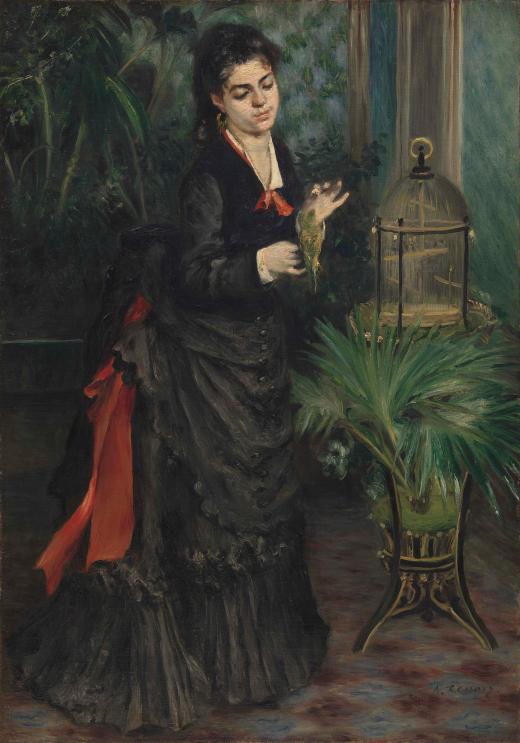
Woman with Parrot, 1871
“I’m returning the photographs of the two paintings along with this letter. The Woman with Parrot must have been done...in 1871 at the latest, because after this time I lost sight of the woman who posed for this picture. In any event, they are of no value, especially the Woman with Bird [sic]. Pray do not get too excited over such daubs.” [1]
Pierre Auguste Renoir (1841–1919) was born in Limoges, France, on February 25, 1841. At age 14, he became an apprentice porcelain painter and grew adept at painting designs on china. Renoir’s early work was influenced by two French artists, Claude Monet, in his treatment of light, and the romantic painter Eugène Delacroix, in his treatment of color.
Renoir first exhibited his paintings in Paris in 1864, but he did not gain recognition until 1874, at the first exhibition of painters of the new Impressionist school. He became a leading member of the Impressionism, sharing with its members an interest in catching the fleeting effect of light and atmosphere on color and form. Unlike the many Impressionists who focused primarily on landscape, Renoir was as much interested in painting the single human figure or family group portraits as he was in landscapes. To him composition and form were as important as rendering the effects of light. Renoir exhibited with the group at the independent shows they organized in the 1870s as an alternative to the official annual Salon in Paris. Renoir fully established his reputation with a solo exhibition held at the Durand-Ruel Gallery in Paris in 1883.
During the last 20 years of his life Renoir was crippled by arthritis; unable to move his hands freely, he continued to paint using a brush strapped to his arm. Renoir died at Cagnes, a village in the south of France, on December 3, 1919.
The woman holding the parrot in the painting Woman with Parrot, 1871 is Renoir’s friend and companion of six years, Lise Tréhot, whose youthful features are recognizable in no fewer than 16 other canvases the artist painted between 1867 and 1872. The woman holds a parrot, a popular and exotic pet at the time. The black taffeta dress with white cuffs and red sash accentuate Lise’s dark hair and white skin; the dark green walls and plants suggest a rather heavy and formal interior.
The feathery, richly textured brushwork suggests that the artist has captured a lovely young bourgeois woman passing some free time. However, the picture’s emphasis on somber hues, the woman’s ambivalent expression, and the claustrophobic space she occupies indicate that this is not merely a glimpse at a frivolous pastime. The spiky fronds of the plants beneath the model close in on her, restricting her space, like that of the bird. That the woman can be read as a caged bird is further suggested by her elaborate, ruffled dress with its red ribbons and her pensive expression. This painting has also been described as a celebration of the color black, which Renoir called “the queen of the colors.”
Preguntas
What is happening in this painting? Describe it as completely as possible.
If this painting were to suddenly come to life, what sounds would you hear? What would happen next?
Take the pose of the woman in this painting. Describe how it feels.
Describe a day in her life. What time does she get up? What does she eat for breakfast? What kind of things might she do in a typical day? Which details in the painting support your ideas? Do you believe her life to be similar to or different from yours? How so? Would you like to trade places with her for a day? Why or why not?
Describe the environment that the painting suggests. Where are we? What time period is it? What do you see that supports your conclusions?
This painting has been described as a celebration of the color black, which Renoir called “the queen of the colors.” Why might Renoir have said that? Do you agree or disagree?
This is a painting of a woman who the artist actually knew named Lise Tréhot (1848–1922). She was 23 years old when she posed for this painting. If you could, what questions would you like to ask her?
